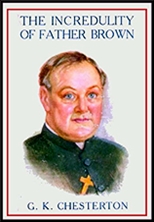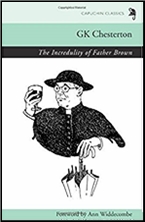Tue 5 May 2020
A 1001 Midnights Review: G. K. CHESTERTON – The Incredulity of Father Brown.
Posted by Steve under 1001 Midnights , Reviews[3] Comments
by Edward D. Hoch

G. K. CHESTERTON – The Incredulity of Father Brown. Dodd Mead, US, hardcover, 1926. First published in the UK by Cassell, hardcover, 1926,. Many reprint editions exist.
As several critics have observed, the Father Brown stories are small gems to be relished sparingly. If too many are read at one time, the effect is lessened and one might even begin to pick holes in their logic. But as detective stories, they are still masterpieces, and the most lasting of all the writing Chesterton produced in his prolific career. Their influence upon later mystery writers — especially John Dickson Carr – was enormous, and Carr’s major detective character, Dr. Gideon Fell, was patterned after Chesterton himself.

The Incredulity of Father Brown is not the best of the five Brown collections, but it is unique in that seven of its eight stories contain locked rooms or impossible crimes as a part of their plot. One of these, “The Oracle of the Dog,” is perhaps the best of all Father Brown stories, and one of the best detective short stories ever written. The stabbing death of Colonel Druce while alone in .a summerhouse whose only entrance is under constant observation, together with a dog that seems to howl at the moment of the colonel’s death, sets up a classic situation in which the impossibility of the crime is linked to a seemingly supernatural event. It was a situation to be explored often by Carr and other writers that followed, but their solutions have rarely been us ingenious as the one Chesterton offers here.

The other six impossible-crime stories in the book are “The Arrow of Heaven,” in which an American millionaire is killed by an arrow inside a guarded room; “The Miracle of Moon Crescent,” featuring the disappearance of a man from a guarded apartment; “The Curse of the Golden Cross,” about a curse on defilers of an ancient tomb; “The Dagger with Wings,” in which a strange cloaked figure is found dead in unmarked snow; “The Doom of the Darnaways,” involving a locked-room poisoning: and “The Ghost of Gideon Wise,” wherein Father Brown is confronted with a ghostly appearance. In all, the atmosphere of the inexplicable is brilliantly realized.
———
Reprinted with permission from 1001 Midnights, edited by Bill Pronzini & Marcia Muller and published by The Battered Silicon Dispatch Box, 2007. Copyright © 1986, 2007 by the Pronzini-Muller Family Trust.
May 5th, 2020 at 8:36 pm
I know many are offended by Chesterton’s racial views (the views and caricatures offend just about anyone), but he is one of the key figures in the genre, and it is hard to get around Father Brown as one of the great detectives and Chesterton as one of the best writers.
At his best his tales are convincing and often stirring. I grant Hoch’s point you might not want to read too many together, or apply too much logic to some, but it is hard to miss the power of “Oracle of the Dog,” “The Blast of the Book,” or “The Invisible Man.”
The mix of humor, a hint of the supernatural, clever solutions, and the real power of Father Brown when he rises like an old testament prophet from this meek guise still works.
May 5th, 2020 at 8:55 pm
As it so happened, I read the COMPLETE FATHER BROWN from cover to cover one summer vacation when my parents rented a cabin for a couple of weeks. Or at least that’s how I remember it, I was very young, but not so young that I didn’t enjoy them immensely. I think I read all the way through EQ’s 101 YEAR’S ENTERTAINMENT those same two weeks. No wonder I’m the person I am now.
Coming up soon on this blog is Ed Hoch’s followup review of THE INNOCENCE OF FATHER BROWN, which he says “contains more classic short stories than almost any other mystery collection before or since.”
August 28th, 2023 at 9:29 am
[…] others, by Nick Fuller at The Grandest Game in the World, dfordoom at Vintage Pop Fictions, Edward D. Hoch at Mystery File, Karyn Reeves at A Penguin A […]